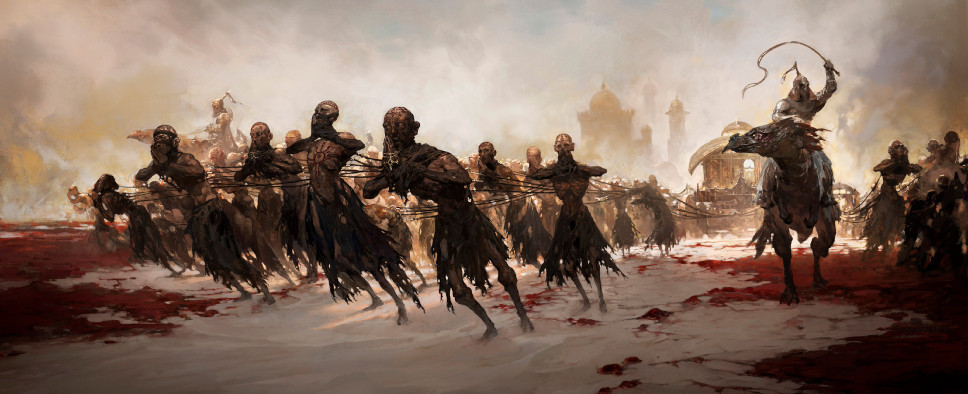Path of Exile 2 - Narrative Design Philosophies
-
Category: News ArchiveHits: 1168

Having recently shared some fresh Path of Exile 2 footage, Grinding Gear Games now brings us this article where they talk about their approach to narrative design in the upcoming action-RPG sequel. And what with the game's enhanced reactivity and a new focus on choices and consequences, things aren't looking too shabby. Check it out:
In Path of Exile 2, much has changed in the world of Wraeclast, which means that the way we approach telling its story also needs to be different. In today's news post, Narrative Designer Matt Dymerski, shares some of the narrative design philosophies being adopted to craft a more immersive story and experience in Path of Exile 2.
The following is written from Matt's perspective.
Newer players might not realize this, but Path of Exile was written in stages. When I started playing, the Lunaris Temple was the end of the game, and Piety was the final boss. Act 4 didn’t arrive until 2015, and Acts 5 through 10 followed in 2017. The years between saw significant upgrades in Grinding Gear Games’ capabilities and focus, but also held complications with the availability of voice actors and writers. Path of Exile 2 represents the company’s first opportunity to build a complete sequel story all at once. That means myself - your resident Narrative Designer - and a team of fantastic level designers, artists, and voice actors will be along for the entire ride. With that in mind, I’d like to share some narrative design philosophies about how we’re approaching the story and experience of Path of Exile 2.
First and foremost, we’re approaching Wraeclast as a living world. Allies and antagonists alike have their own goals and desires. They’re looting ancient artifacts, they’re out waging war, and sometimes, if you anger them enough, they might even come looking for you when you least expect it - because the malevolent forces at play in Path of Exile 2 are smart, capable, and dedicated to their cause. They’ll be making moves against you while you carve your way across the continent. Twenty years before, they saw what a talented Exile can do, so they’ll quickly realize what you represent. Take that as you will...
With enemies making more interesting choices, we want the player to be able to do so in kind, both to aid replayability and to improve immersion. Story-wise, we aim to give the player choices to make about how to proceed through an act. Wherever possible, these choices will also have consequences. Sometimes, you may not be able to achieve all of your objectives, and you’ll have to choose - and events will play out differently as a result. For another example, quests are being designed with all of our types of players in mind. Often, if you skip talking to an NPC, you’ll still be able to pick up a vague version of their quest from environmental clues along the way. If you manage to skip the clues as well and complete the quest completely blind, the NPCs will be grateful, but possibly bewildered. From their perspective, you’re a crazed antisocial barbarian who charged through their town, killed a bunch of monsters, then randomly brought them a highly personal item like a cat dropping off a dead bird. But thanks, I suppose?
Hopefully, these choices will help us minimize the classic RPG feeling of a ‘random walk.’ Every place we go should be intentional. We’ll hitch a ride on caravans. We’ll ride rhoas. Maybe we’ll take a boat. This expands the size of the world and lets us go to cooler destinations, because it’s not believable that multiple different wonders of the world are next to each other, but it is believable that we could travel weeks overland to reach each of them - in real time (just kidding, this isn’t Desert Bus).
This is all part of another intentional design philosophy: story through action. We’re well aware that Path of Exile hosts players of many types, many of which rarely listen to dialogue. For better immersion, we’re shifting what we can into actual events. While the ‘living world’ I’ve described is happening, the player gets to run and fight, and what they perceive about the story should be much more active. Don’t be surprised if you encounter NPCs out in the world having conversations before you arrive or already fighting the good fight. Figuring out who they are fighting and why will have to happen naturally in the course of battle!
All of this should hopefully combine to create a connected world that works so well that you can actually guess what NPCs might do based on their personality or history. The events of Path of Exile 1 certainly lend themselves to this, given that the characters involved have had twenty years to react. There’s a ton more I’d like to get into in the future, but for now I’ll leave off with an open-ended question: in terms of places and people, what would you most like to see again from Path of Exile 1?
Beyond that, there’s also this article with a to-do list for the recently-released Ultimatum expansion.

